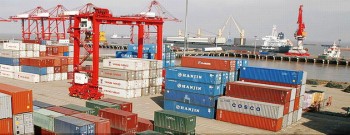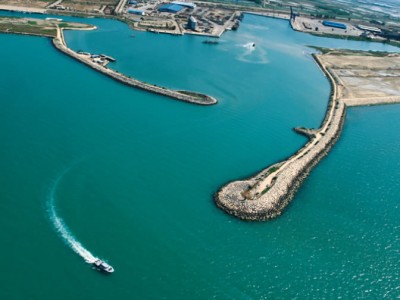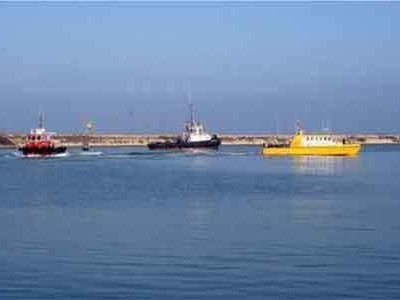Container Terminal Operation and Cargo Handling By "Sea Red Sail Co"
Container terminals are designated for the handling, storage, and possibly loading or
unloading of cargo into or out of containers, and where containers can be picked up, dropped off, maintained, stored, or loaded or unloaded from one model of transport to another (that is, vessel, truck, barge, or rail).
Figure 1. Container Terminal
World container terminals are classified into five categories by their ownerships:
public terminals, carrier-leased dedicated terminals, terminal-operator built and operation terminals, carrier built and operation terminals, and joint venture of carriers and terminal operators. The operation characteristics of the five patterns are specified as bellow.
Public terminals
All the shipping lines share with each other the facilities of public terminals in loading and discharging, and are charged at tariff rates, generally with a ‘first come, first serve’ principle and without any priority in berth usage except paying priority tolls. Container handling and other charges are calculated at common tariff rates, or paid at quantity discount rates in case container volume is over the fixed quantity agreed upon in contracts.
Carrier-leased dedicated terminals
Carriers sign long-term lease contracts with the port authorities for their own exclusive use. Carriers pay rents and facility charges and the port authorities entitle contract carriers to right and priority in berth usage. Carrier could be entitled to purchase or install container handling facilities at his own account to compensate for rents and facility charges. Owing to the joint services among shipping lines, single user long-term contracts are transferred to multi-user contracts so that several shipping lines share terminal usage.
Terminal-operator built and operation terminals
By making a deposit and allocating to the port authorities in proportion to the total handling charges as agreed in the contract, a terminal operator leases container terminals or invests directly in the construction, operation of container terminals and handling facilities. Amirabad and Anzali ports are categorized into this operation pattern.
Carrier built and operation terminals
By making a deposit and allocating to the port authorities in proportion to the total handling charges as agreed in the contract, a carrier or several carriers lease container terminals or invest directly in the construction, operation of container terminals and handling facilities. Except the usage of their fleet, the carriers are entitled to provide other shipping lines with berthing and container handling services. Amirabad and Anzali ports are categorized into this operation pattern.
Joint venture of carriers and terminal operators
By making a deposit and allocating to the port authorities in proportion to the total handling charges as agreed in the contract, a joint venture of shipping lines and terminal operators establishes a company, or makes a joint investment in leasing container terminals or invest directly in the construction, operation of container terminals and handling facilities.
Berth
A place in which a vessel is moored or secured; place alongside a quay where a ship loads or discharges cargo.
Container yard (CY)
A container handling and storage facility either within a port or inland. CY is the loaded containers and lend out empty containers or receive returned empty containers.
Container freight station (CFS)
A dedicated port or container terminal area, usually consisting of one or more sheds or warehouses and uncovered storage areas where cargo is loaded (“stuffed”) into or unloaded(“stripped”) from containers and may be temporarily stored in the sheds or warehouses.
Customhouse
A government office where duties are paid, documents filed, and so forth, on foreign shipments.
Bonded warehouse
A warehouse authorized by customs authorities for storage of goods on which payment of duties is deferred until the goods are removed.
Chassis
A frame with wheels and container locking devices to secure the container for movement.
Pallet
A flat tray, generally made of wood, but occasionally steel or other materials, on measures 1 x 1.2 meters, and the euro pallet at 0.8 x 1.2 meters.
Gantry crane
A crane fixed on a frame or structure spanning an intervening space typically designed to traverse fixed structures such as cargo (container) storage areas or quays and which is used to hoist containers or other cargo in and out of vessels and place or lift from a vessel, barge, trucks, chassis, or train.
Spreader
A piece of equipment designed to lift containers by their corner castings.
Rail-mounted gantry (RMG)
Rail-mounted gantry crane used for container acceptance, delivery, and stacking operations in a container yard.
Rubber-tired gantry (RTG)
Gantry crane on rubber tires typically used for acceptance, delivery, and container stacking at a container yard.
Straddle carrier
Type of equipment that picks up and transports containers between its legs for movement within a container terminal.
Top lifter
Forklift truck capable of lifting a container by means of its spreader.
Side loader
A lift truck fitted with lifting attachments operating to one side for handling containers.
Stack car
An articulated multiple platform rail car that allows containers to be double stacked.
Stack train
A rail service whereby rail cars carry containers stacked two high on specially operated unit trains.
Demurrage
A penalty charge against shippers or consignees for delaying the carrier’s equipment beyond the allowed free time.
Heavy lift charge
A charge typically imposed when special lifting gear is required to handle a given piece of cargo, which may be of either heavy weight or of large dimensions (often referred to as “out of gauge” when dealing with container vessels).
Stevedoring charges
Fees for loading and stowing or unloading a ship.
Terminal handling charge (THC)
A charge made for a service performed in a terminal area typically referring to handling associated with receipt, delivery, or inspection of cargo via land-based operations.





 Iranian Rial Exchange Rate
Iranian Rial Exchange Rate